Policing, Justice, and Society - Assessment 2: Short Answer Exercise
VerifiedAdded on 2023/06/13
|8
|2173
|175
Homework Assignment
AI Summary
This assignment provides detailed answers to five short answer questions related to policing, justice, and society. It begins by examining the Community Problem-Solving Era, highlighting its focus on collaboration and crime reduction, along with its strengths and weaknesses. The assignment then defines 'entrapment,' discussing its merits, limitations, and the objective and subjective standards applied in legal contexts. The PEACE model, used for interviewing suspects, is explained in detail, covering the five phases: Planning and preparation, Engage and explain, Account clarification and challenge, Closure, and Evaluation. Furthermore, the theory of Critical Victimology is explored, emphasizing the broader social, economic, and political contexts of victimization. Finally, the assignment defines 'human trafficking,' explaining its nature and extent as a transnational organized crime, referencing the UN Convention against Transnational Organized Crime and the Trafficking Protocol.
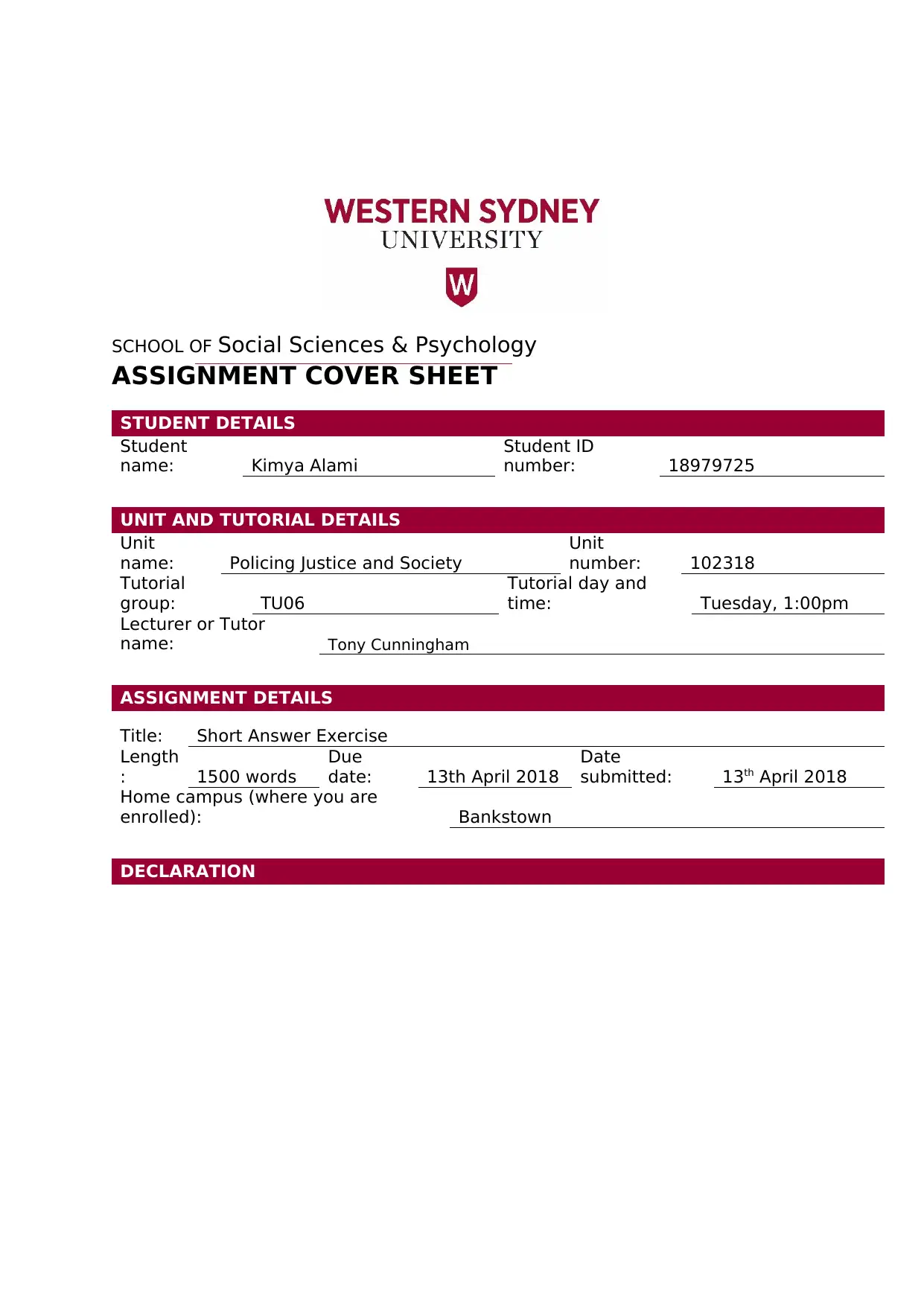
SCHOOL OF Social Sciences & Psychology
ASSIGNMENT COVER SHEET
STUDENT DETAILS
Student
name: Kimya Alami
Student ID
number: 18979725
UNIT AND TUTORIAL DETAILS
Unit
name: Policing Justice and Society
Unit
number: 102318
Tutorial
group: TU06
Tutorial day and
time: Tuesday, 1:00pm
Lecturer or Tutor
name: Tony Cunningham
ASSIGNMENT DETAILS
Title: Short Answer Exercise
Length
: 1500 words
Due
date: 13th April 2018
Date
submitted: 13th April 2018
Home campus (where you are
enrolled): Bankstown
DECLARATION
ASSIGNMENT COVER SHEET
STUDENT DETAILS
Student
name: Kimya Alami
Student ID
number: 18979725
UNIT AND TUTORIAL DETAILS
Unit
name: Policing Justice and Society
Unit
number: 102318
Tutorial
group: TU06
Tutorial day and
time: Tuesday, 1:00pm
Lecturer or Tutor
name: Tony Cunningham
ASSIGNMENT DETAILS
Title: Short Answer Exercise
Length
: 1500 words
Due
date: 13th April 2018
Date
submitted: 13th April 2018
Home campus (where you are
enrolled): Bankstown
DECLARATION
Paraphrase This Document
Need a fresh take? Get an instant paraphrase of this document with our AI Paraphraser
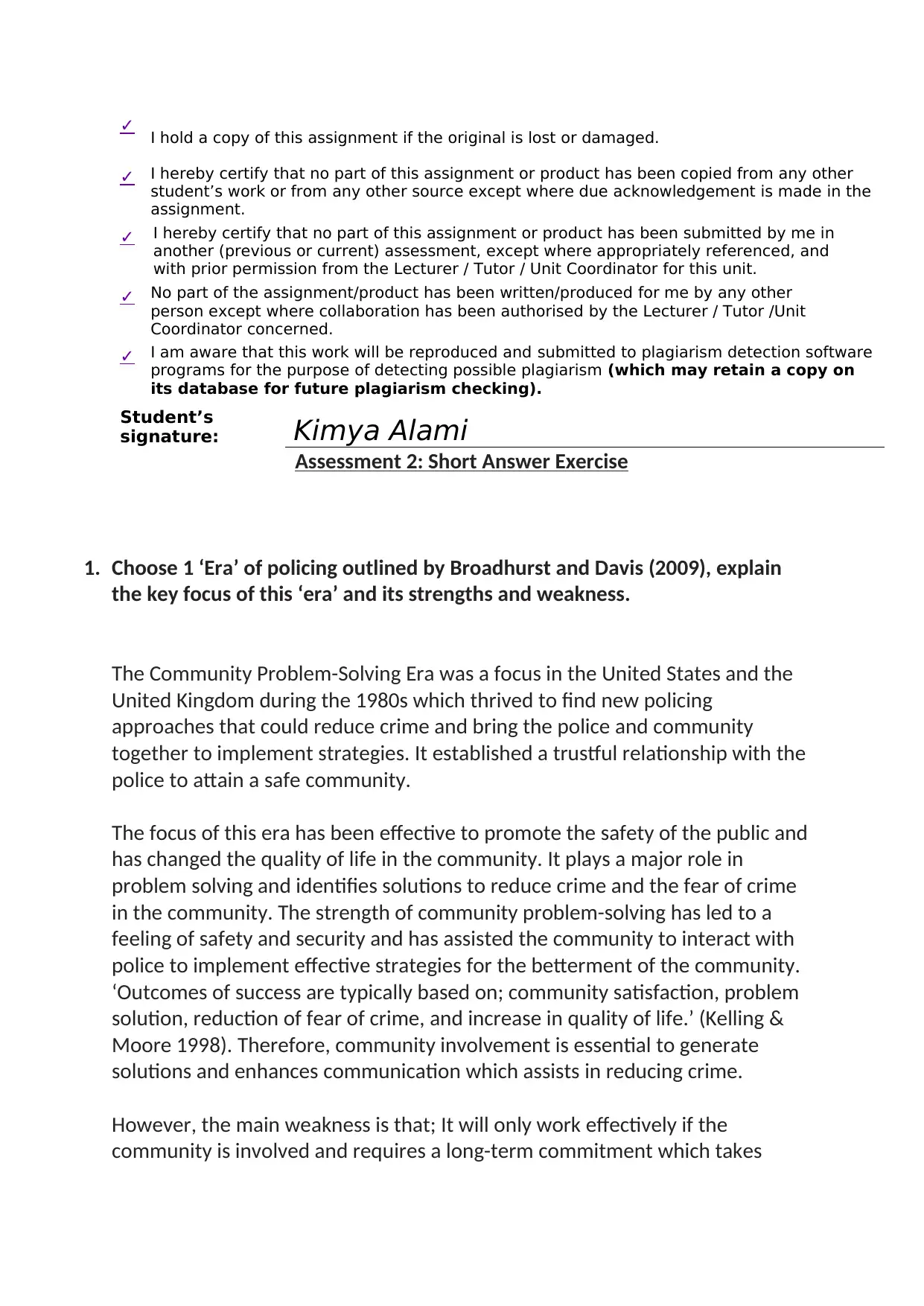
✓ I hold a copy of this assignment if the original is lost or damaged.
✓ I hereby certify that no part of this assignment or product has been copied from any other
student’s work or from any other source except where due acknowledgement is made in the
assignment.
✓ I hereby certify that no part of this assignment or product has been submitted by me in
another (previous or current) assessment, except where appropriately referenced, and
with prior permission from the Lecturer / Tutor / Unit Coordinator for this unit.
✓ No part of the assignment/product has been written/produced for me by any other
person except where collaboration has been authorised by the Lecturer / Tutor /Unit
Coordinator concerned.
✓ I am aware that this work will be reproduced and submitted to plagiarism detection software
programs for the purpose of detecting possible plagiarism (which may retain a copy on
its database for future plagiarism checking).
Student’s
signature: Kimya Alami
Assessment 2: Short Answer Exercise
1. Choose 1 ‘Era’ of policing outlined by Broadhurst and Davis (2009), explain
the key focus of this ‘era’ and its strengths and weakness.
The Community Problem-Solving Era was a focus in the United States and the
United Kingdom during the 1980s which thrived to find new policing
approaches that could reduce crime and bring the police and community
together to implement strategies. It established a trustful relationship with the
police to attain a safe community.
The focus of this era has been effective to promote the safety of the public and
has changed the quality of life in the community. It plays a major role in
problem solving and identifies solutions to reduce crime and the fear of crime
in the community. The strength of community problem-solving has led to a
feeling of safety and security and has assisted the community to interact with
police to implement effective strategies for the betterment of the community.
‘Outcomes of success are typically based on; community satisfaction, problem
solution, reduction of fear of crime, and increase in quality of life.’ (Kelling &
Moore 1998). Therefore, community involvement is essential to generate
solutions and enhances communication which assists in reducing crime.
However, the main weakness is that; It will only work effectively if the
community is involved and requires a long-term commitment which takes
✓ I hereby certify that no part of this assignment or product has been copied from any other
student’s work or from any other source except where due acknowledgement is made in the
assignment.
✓ I hereby certify that no part of this assignment or product has been submitted by me in
another (previous or current) assessment, except where appropriately referenced, and
with prior permission from the Lecturer / Tutor / Unit Coordinator for this unit.
✓ No part of the assignment/product has been written/produced for me by any other
person except where collaboration has been authorised by the Lecturer / Tutor /Unit
Coordinator concerned.
✓ I am aware that this work will be reproduced and submitted to plagiarism detection software
programs for the purpose of detecting possible plagiarism (which may retain a copy on
its database for future plagiarism checking).
Student’s
signature: Kimya Alami
Assessment 2: Short Answer Exercise
1. Choose 1 ‘Era’ of policing outlined by Broadhurst and Davis (2009), explain
the key focus of this ‘era’ and its strengths and weakness.
The Community Problem-Solving Era was a focus in the United States and the
United Kingdom during the 1980s which thrived to find new policing
approaches that could reduce crime and bring the police and community
together to implement strategies. It established a trustful relationship with the
police to attain a safe community.
The focus of this era has been effective to promote the safety of the public and
has changed the quality of life in the community. It plays a major role in
problem solving and identifies solutions to reduce crime and the fear of crime
in the community. The strength of community problem-solving has led to a
feeling of safety and security and has assisted the community to interact with
police to implement effective strategies for the betterment of the community.
‘Outcomes of success are typically based on; community satisfaction, problem
solution, reduction of fear of crime, and increase in quality of life.’ (Kelling &
Moore 1998). Therefore, community involvement is essential to generate
solutions and enhances communication which assists in reducing crime.
However, the main weakness is that; It will only work effectively if the
community is involved and requires a long-term commitment which takes

time. ‘It is proposed that police need to engage with the community to discuss
priorities and to develop problem-solving strategies’. (Bayley 1998)
This exemplifies that community engagement is important in order to
eliminate problems in the community. ‘A major issue for police organisations
when implementing community policing is the presence of strong personalities
and influential groups, who may dominate discussions and control the
initiative’s direction’. (Thurman et al 2001)
Therefore, the strengths of community problem-solving era outweighs the
disadvantages. The attempt of community problem solving era has effective
long-term crime prevention strategies to make these practices more lawful in
the community.
2. Describe and define ‘entrapment’, examine its merits and limitations.
‘Entrapment is a practice where a law enforcement agent provokes a person to
commit a criminal offence which the person would have otherwise, been
unwilling to commit’. (Marcus 2015). It is used as a defence to criminal charges
and is based on the communication between the defendant and police officers
prior to the commission of the alleged crime.
Entrapment emphasizes on the origin of the criminal intention, so, if criminal
intention originates with the law or government enforcement, the defendant is
entrapped and can be used as a defence. If the criminal intention originates
with the defendant can be convicted of the alleged offence.
Entrapment is subjected to two tests namely, objective and subjective
entrapment. The Subjective standard usually emphasizes on the characteristics
of the individual/defendant. It refers to the standard where the defendant
uses entrapment as defence and the court will decide whether the defendant
was inclined to the committing of the offense in the absence of pressure from
the law enforcement. If the facts indicate the same, the defendant cannot use
the defence of entrapment (Davies 2010).
As per the Objective standard, it emphasizes on the behaviour of the law
enforcement instead of the individual characteristic of the defendant. If it is
established that the tactics used by the law enforcement can provoke a law-
priorities and to develop problem-solving strategies’. (Bayley 1998)
This exemplifies that community engagement is important in order to
eliminate problems in the community. ‘A major issue for police organisations
when implementing community policing is the presence of strong personalities
and influential groups, who may dominate discussions and control the
initiative’s direction’. (Thurman et al 2001)
Therefore, the strengths of community problem-solving era outweighs the
disadvantages. The attempt of community problem solving era has effective
long-term crime prevention strategies to make these practices more lawful in
the community.
2. Describe and define ‘entrapment’, examine its merits and limitations.
‘Entrapment is a practice where a law enforcement agent provokes a person to
commit a criminal offence which the person would have otherwise, been
unwilling to commit’. (Marcus 2015). It is used as a defence to criminal charges
and is based on the communication between the defendant and police officers
prior to the commission of the alleged crime.
Entrapment emphasizes on the origin of the criminal intention, so, if criminal
intention originates with the law or government enforcement, the defendant is
entrapped and can be used as a defence. If the criminal intention originates
with the defendant can be convicted of the alleged offence.
Entrapment is subjected to two tests namely, objective and subjective
entrapment. The Subjective standard usually emphasizes on the characteristics
of the individual/defendant. It refers to the standard where the defendant
uses entrapment as defence and the court will decide whether the defendant
was inclined to the committing of the offense in the absence of pressure from
the law enforcement. If the facts indicate the same, the defendant cannot use
the defence of entrapment (Davies 2010).
As per the Objective standard, it emphasizes on the behaviour of the law
enforcement instead of the individual characteristic of the defendant. If it is
established that the tactics used by the law enforcement can provoke a law-
⊘ This is a preview!⊘
Do you want full access?
Subscribe today to unlock all pages.

Trusted by 1+ million students worldwide
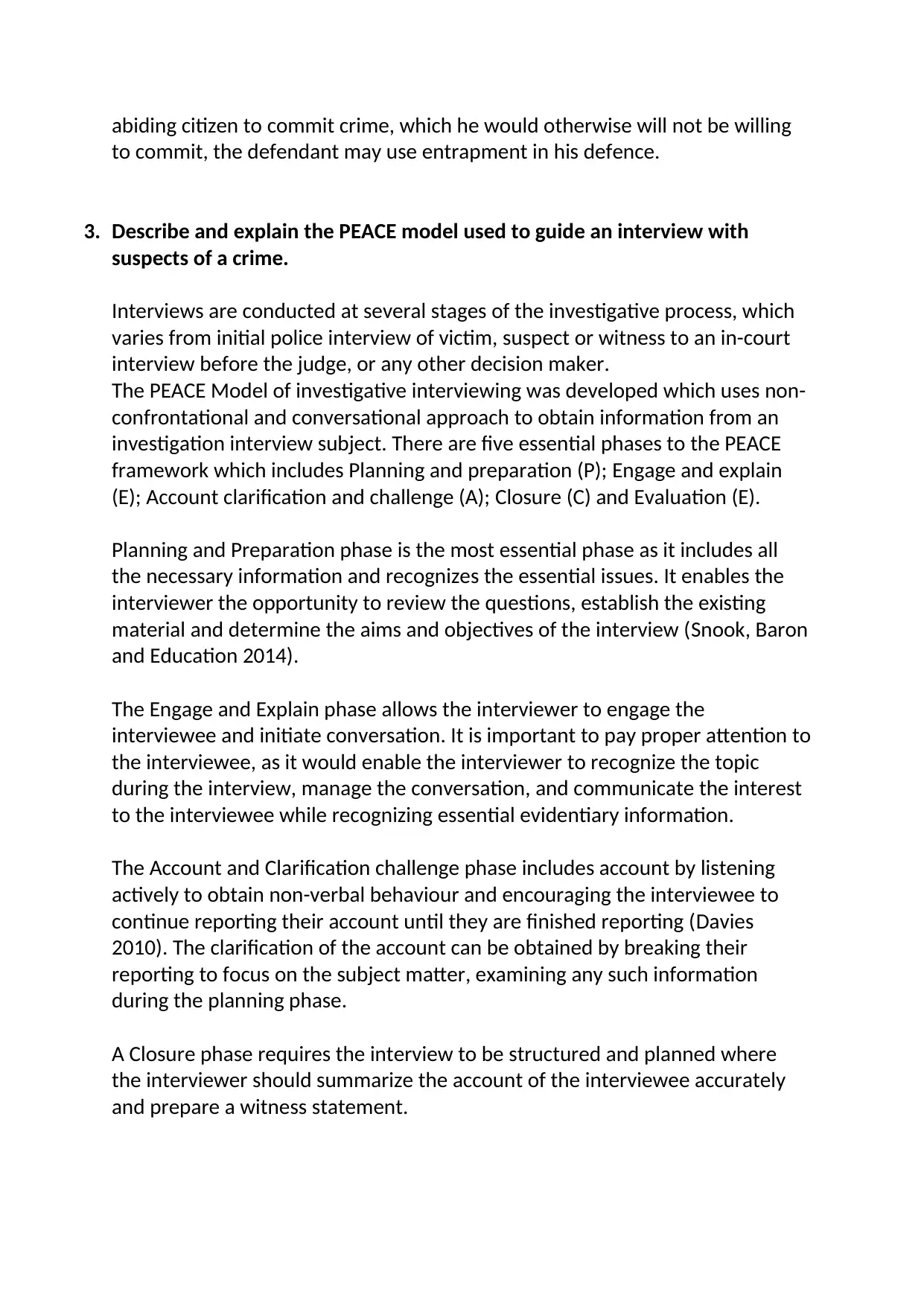
abiding citizen to commit crime, which he would otherwise will not be willing
to commit, the defendant may use entrapment in his defence.
3. Describe and explain the PEACE model used to guide an interview with
suspects of a crime.
Interviews are conducted at several stages of the investigative process, which
varies from initial police interview of victim, suspect or witness to an in-court
interview before the judge, or any other decision maker.
The PEACE Model of investigative interviewing was developed which uses non-
confrontational and conversational approach to obtain information from an
investigation interview subject. There are five essential phases to the PEACE
framework which includes Planning and preparation (P); Engage and explain
(E); Account clarification and challenge (A); Closure (C) and Evaluation (E).
Planning and Preparation phase is the most essential phase as it includes all
the necessary information and recognizes the essential issues. It enables the
interviewer the opportunity to review the questions, establish the existing
material and determine the aims and objectives of the interview (Snook, Baron
and Education 2014).
The Engage and Explain phase allows the interviewer to engage the
interviewee and initiate conversation. It is important to pay proper attention to
the interviewee, as it would enable the interviewer to recognize the topic
during the interview, manage the conversation, and communicate the interest
to the interviewee while recognizing essential evidentiary information.
The Account and Clarification challenge phase includes account by listening
actively to obtain non-verbal behaviour and encouraging the interviewee to
continue reporting their account until they are finished reporting (Davies
2010). The clarification of the account can be obtained by breaking their
reporting to focus on the subject matter, examining any such information
during the planning phase.
A Closure phase requires the interview to be structured and planned where
the interviewer should summarize the account of the interviewee accurately
and prepare a witness statement.
to commit, the defendant may use entrapment in his defence.
3. Describe and explain the PEACE model used to guide an interview with
suspects of a crime.
Interviews are conducted at several stages of the investigative process, which
varies from initial police interview of victim, suspect or witness to an in-court
interview before the judge, or any other decision maker.
The PEACE Model of investigative interviewing was developed which uses non-
confrontational and conversational approach to obtain information from an
investigation interview subject. There are five essential phases to the PEACE
framework which includes Planning and preparation (P); Engage and explain
(E); Account clarification and challenge (A); Closure (C) and Evaluation (E).
Planning and Preparation phase is the most essential phase as it includes all
the necessary information and recognizes the essential issues. It enables the
interviewer the opportunity to review the questions, establish the existing
material and determine the aims and objectives of the interview (Snook, Baron
and Education 2014).
The Engage and Explain phase allows the interviewer to engage the
interviewee and initiate conversation. It is important to pay proper attention to
the interviewee, as it would enable the interviewer to recognize the topic
during the interview, manage the conversation, and communicate the interest
to the interviewee while recognizing essential evidentiary information.
The Account and Clarification challenge phase includes account by listening
actively to obtain non-verbal behaviour and encouraging the interviewee to
continue reporting their account until they are finished reporting (Davies
2010). The clarification of the account can be obtained by breaking their
reporting to focus on the subject matter, examining any such information
during the planning phase.
A Closure phase requires the interview to be structured and planned where
the interviewer should summarize the account of the interviewee accurately
and prepare a witness statement.
Paraphrase This Document
Need a fresh take? Get an instant paraphrase of this document with our AI Paraphraser
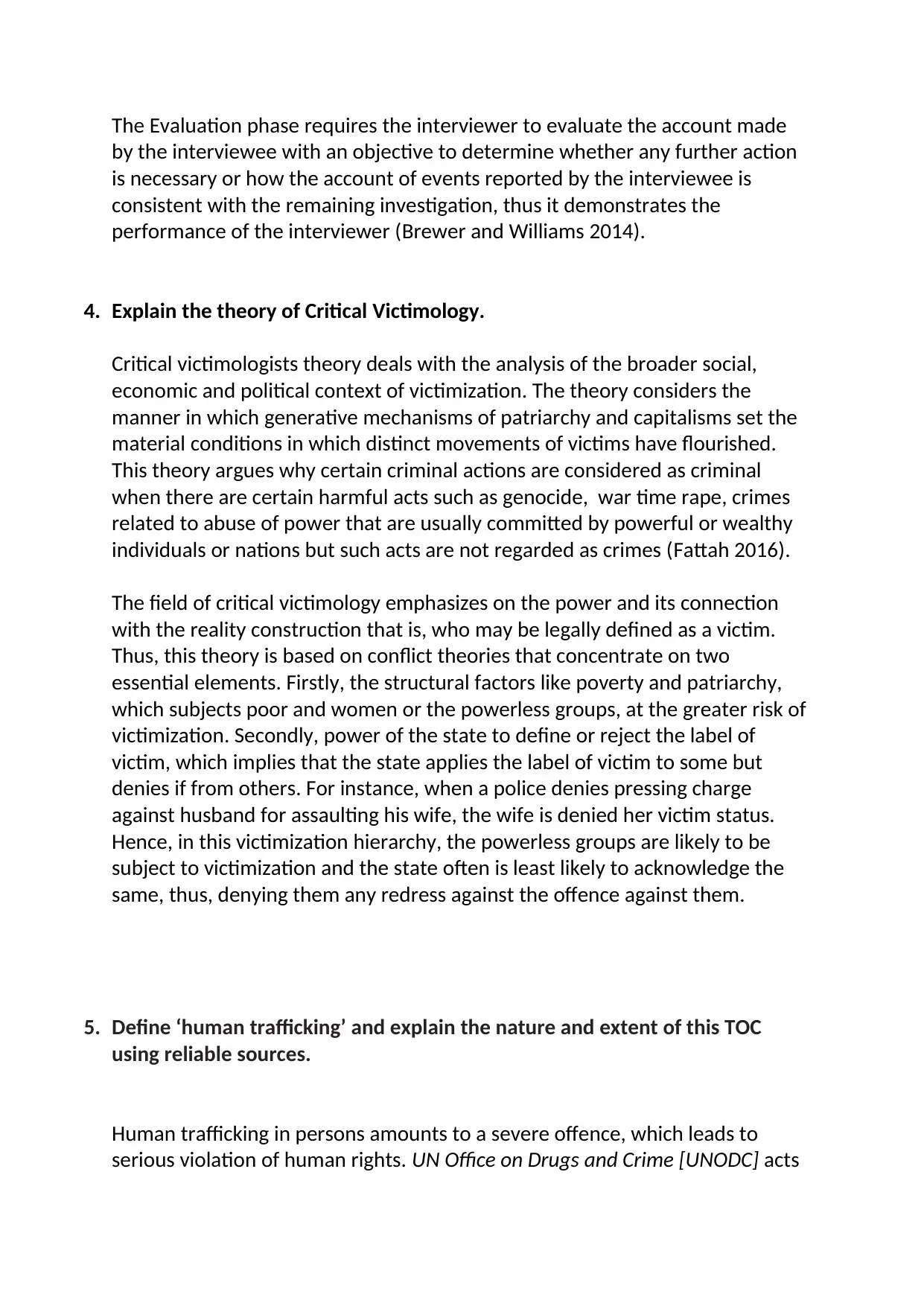
The Evaluation phase requires the interviewer to evaluate the account made
by the interviewee with an objective to determine whether any further action
is necessary or how the account of events reported by the interviewee is
consistent with the remaining investigation, thus it demonstrates the
performance of the interviewer (Brewer and Williams 2014).
4. Explain the theory of Critical Victimology.
Critical victimologists theory deals with the analysis of the broader social,
economic and political context of victimization. The theory considers the
manner in which generative mechanisms of patriarchy and capitalisms set the
material conditions in which distinct movements of victims have flourished.
This theory argues why certain criminal actions are considered as criminal
when there are certain harmful acts such as genocide, war time rape, crimes
related to abuse of power that are usually committed by powerful or wealthy
individuals or nations but such acts are not regarded as crimes (Fattah 2016).
The field of critical victimology emphasizes on the power and its connection
with the reality construction that is, who may be legally defined as a victim.
Thus, this theory is based on conflict theories that concentrate on two
essential elements. Firstly, the structural factors like poverty and patriarchy,
which subjects poor and women or the powerless groups, at the greater risk of
victimization. Secondly, power of the state to define or reject the label of
victim, which implies that the state applies the label of victim to some but
denies if from others. For instance, when a police denies pressing charge
against husband for assaulting his wife, the wife is denied her victim status.
Hence, in this victimization hierarchy, the powerless groups are likely to be
subject to victimization and the state often is least likely to acknowledge the
same, thus, denying them any redress against the offence against them.
5. Define ‘human trafficking’ and explain the nature and extent of this TOC
using reliable sources.
Human trafficking in persons amounts to a severe offence, which leads to
serious violation of human rights. UN Office on Drugs and Crime [UNODC] acts
by the interviewee with an objective to determine whether any further action
is necessary or how the account of events reported by the interviewee is
consistent with the remaining investigation, thus it demonstrates the
performance of the interviewer (Brewer and Williams 2014).
4. Explain the theory of Critical Victimology.
Critical victimologists theory deals with the analysis of the broader social,
economic and political context of victimization. The theory considers the
manner in which generative mechanisms of patriarchy and capitalisms set the
material conditions in which distinct movements of victims have flourished.
This theory argues why certain criminal actions are considered as criminal
when there are certain harmful acts such as genocide, war time rape, crimes
related to abuse of power that are usually committed by powerful or wealthy
individuals or nations but such acts are not regarded as crimes (Fattah 2016).
The field of critical victimology emphasizes on the power and its connection
with the reality construction that is, who may be legally defined as a victim.
Thus, this theory is based on conflict theories that concentrate on two
essential elements. Firstly, the structural factors like poverty and patriarchy,
which subjects poor and women or the powerless groups, at the greater risk of
victimization. Secondly, power of the state to define or reject the label of
victim, which implies that the state applies the label of victim to some but
denies if from others. For instance, when a police denies pressing charge
against husband for assaulting his wife, the wife is denied her victim status.
Hence, in this victimization hierarchy, the powerless groups are likely to be
subject to victimization and the state often is least likely to acknowledge the
same, thus, denying them any redress against the offence against them.
5. Define ‘human trafficking’ and explain the nature and extent of this TOC
using reliable sources.
Human trafficking in persons amounts to a severe offence, which leads to
serious violation of human rights. UN Office on Drugs and Crime [UNODC] acts
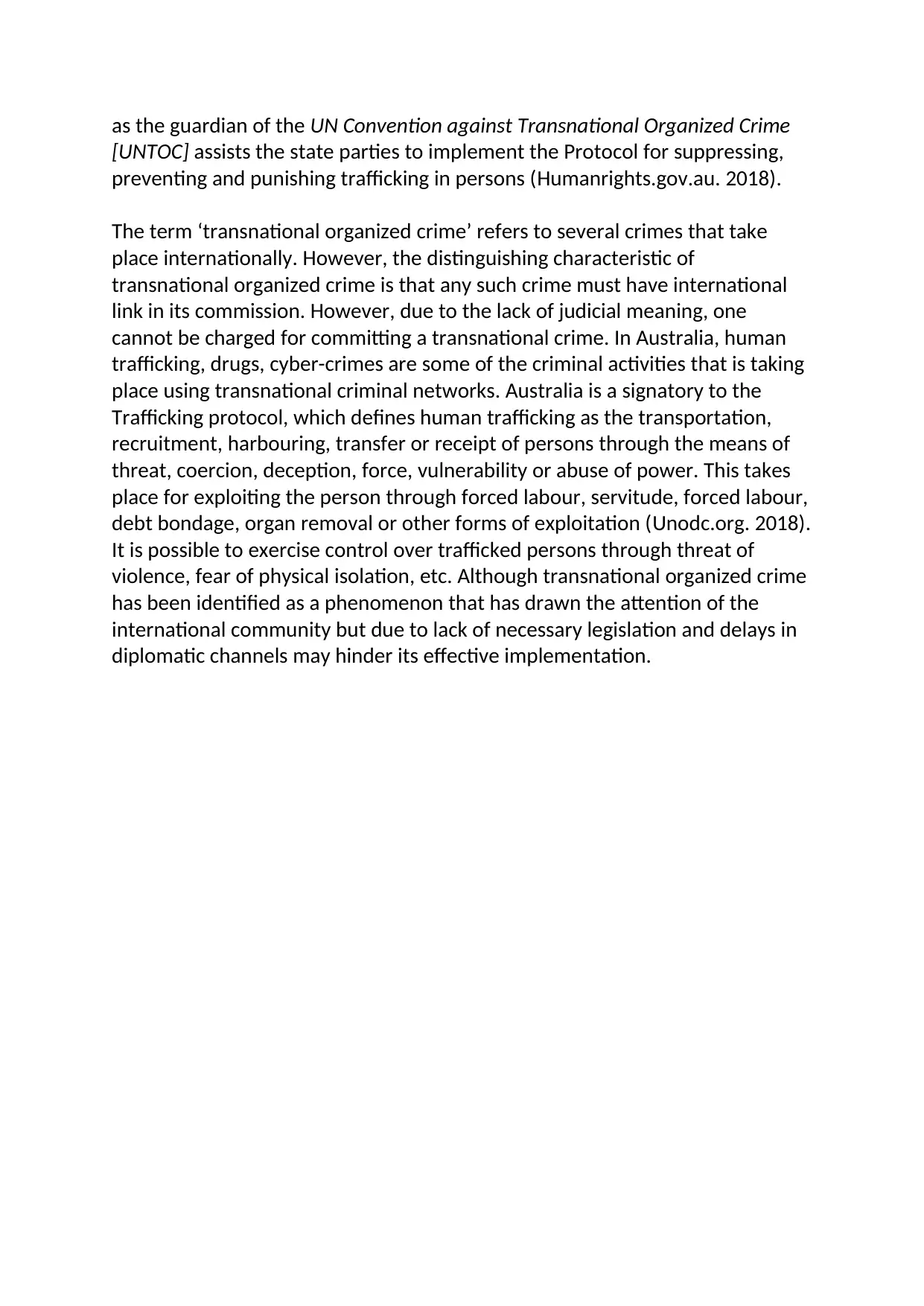
as the guardian of the UN Convention against Transnational Organized Crime
[UNTOC] assists the state parties to implement the Protocol for suppressing,
preventing and punishing trafficking in persons (Humanrights.gov.au. 2018).
The term ‘transnational organized crime’ refers to several crimes that take
place internationally. However, the distinguishing characteristic of
transnational organized crime is that any such crime must have international
link in its commission. However, due to the lack of judicial meaning, one
cannot be charged for committing a transnational crime. In Australia, human
trafficking, drugs, cyber-crimes are some of the criminal activities that is taking
place using transnational criminal networks. Australia is a signatory to the
Trafficking protocol, which defines human trafficking as the transportation,
recruitment, harbouring, transfer or receipt of persons through the means of
threat, coercion, deception, force, vulnerability or abuse of power. This takes
place for exploiting the person through forced labour, servitude, forced labour,
debt bondage, organ removal or other forms of exploitation (Unodc.org. 2018).
It is possible to exercise control over trafficked persons through threat of
violence, fear of physical isolation, etc. Although transnational organized crime
has been identified as a phenomenon that has drawn the attention of the
international community but due to lack of necessary legislation and delays in
diplomatic channels may hinder its effective implementation.
[UNTOC] assists the state parties to implement the Protocol for suppressing,
preventing and punishing trafficking in persons (Humanrights.gov.au. 2018).
The term ‘transnational organized crime’ refers to several crimes that take
place internationally. However, the distinguishing characteristic of
transnational organized crime is that any such crime must have international
link in its commission. However, due to the lack of judicial meaning, one
cannot be charged for committing a transnational crime. In Australia, human
trafficking, drugs, cyber-crimes are some of the criminal activities that is taking
place using transnational criminal networks. Australia is a signatory to the
Trafficking protocol, which defines human trafficking as the transportation,
recruitment, harbouring, transfer or receipt of persons through the means of
threat, coercion, deception, force, vulnerability or abuse of power. This takes
place for exploiting the person through forced labour, servitude, forced labour,
debt bondage, organ removal or other forms of exploitation (Unodc.org. 2018).
It is possible to exercise control over trafficked persons through threat of
violence, fear of physical isolation, etc. Although transnational organized crime
has been identified as a phenomenon that has drawn the attention of the
international community but due to lack of necessary legislation and delays in
diplomatic channels may hinder its effective implementation.
⊘ This is a preview!⊘
Do you want full access?
Subscribe today to unlock all pages.

Trusted by 1+ million students worldwide
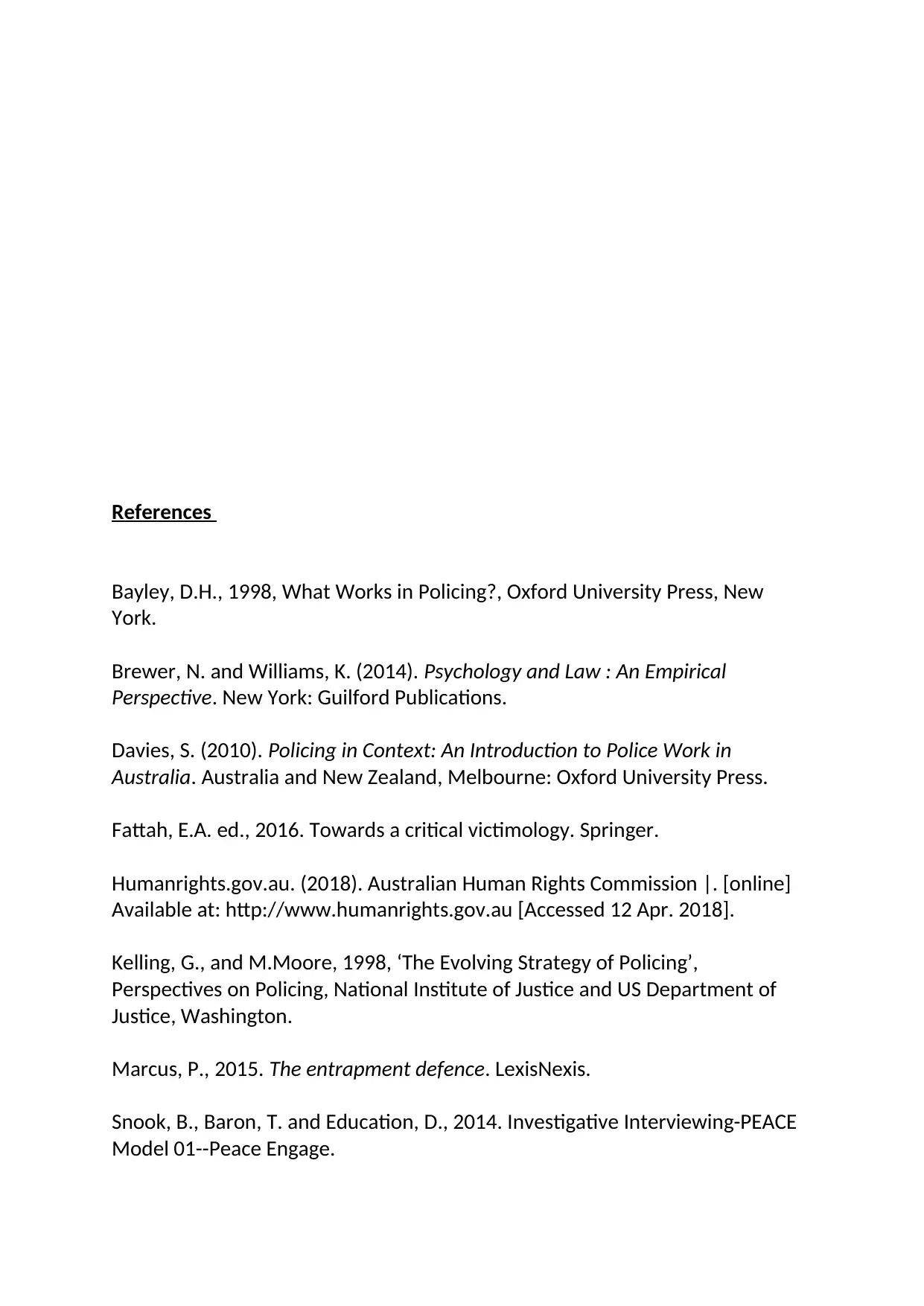
References
Bayley, D.H., 1998, What Works in Policing?, Oxford University Press, New
York.
Brewer, N. and Williams, K. (2014). Psychology and Law : An Empirical
Perspective. New York: Guilford Publications.
Davies, S. (2010). Policing in Context: An Introduction to Police Work in
Australia. Australia and New Zealand, Melbourne: Oxford University Press.
Fattah, E.A. ed., 2016. Towards a critical victimology. Springer.
Humanrights.gov.au. (2018). Australian Human Rights Commission |. [online]
Available at: http://www.humanrights.gov.au [Accessed 12 Apr. 2018].
Kelling, G., and M.Moore, 1998, ‘The Evolving Strategy of Policing’,
Perspectives on Policing, National Institute of Justice and US Department of
Justice, Washington.
Marcus, P., 2015. The entrapment defence. LexisNexis.
Snook, B., Baron, T. and Education, D., 2014. Investigative Interviewing-PEACE
Model 01--Peace Engage.
Bayley, D.H., 1998, What Works in Policing?, Oxford University Press, New
York.
Brewer, N. and Williams, K. (2014). Psychology and Law : An Empirical
Perspective. New York: Guilford Publications.
Davies, S. (2010). Policing in Context: An Introduction to Police Work in
Australia. Australia and New Zealand, Melbourne: Oxford University Press.
Fattah, E.A. ed., 2016. Towards a critical victimology. Springer.
Humanrights.gov.au. (2018). Australian Human Rights Commission |. [online]
Available at: http://www.humanrights.gov.au [Accessed 12 Apr. 2018].
Kelling, G., and M.Moore, 1998, ‘The Evolving Strategy of Policing’,
Perspectives on Policing, National Institute of Justice and US Department of
Justice, Washington.
Marcus, P., 2015. The entrapment defence. LexisNexis.
Snook, B., Baron, T. and Education, D., 2014. Investigative Interviewing-PEACE
Model 01--Peace Engage.
Paraphrase This Document
Need a fresh take? Get an instant paraphrase of this document with our AI Paraphraser
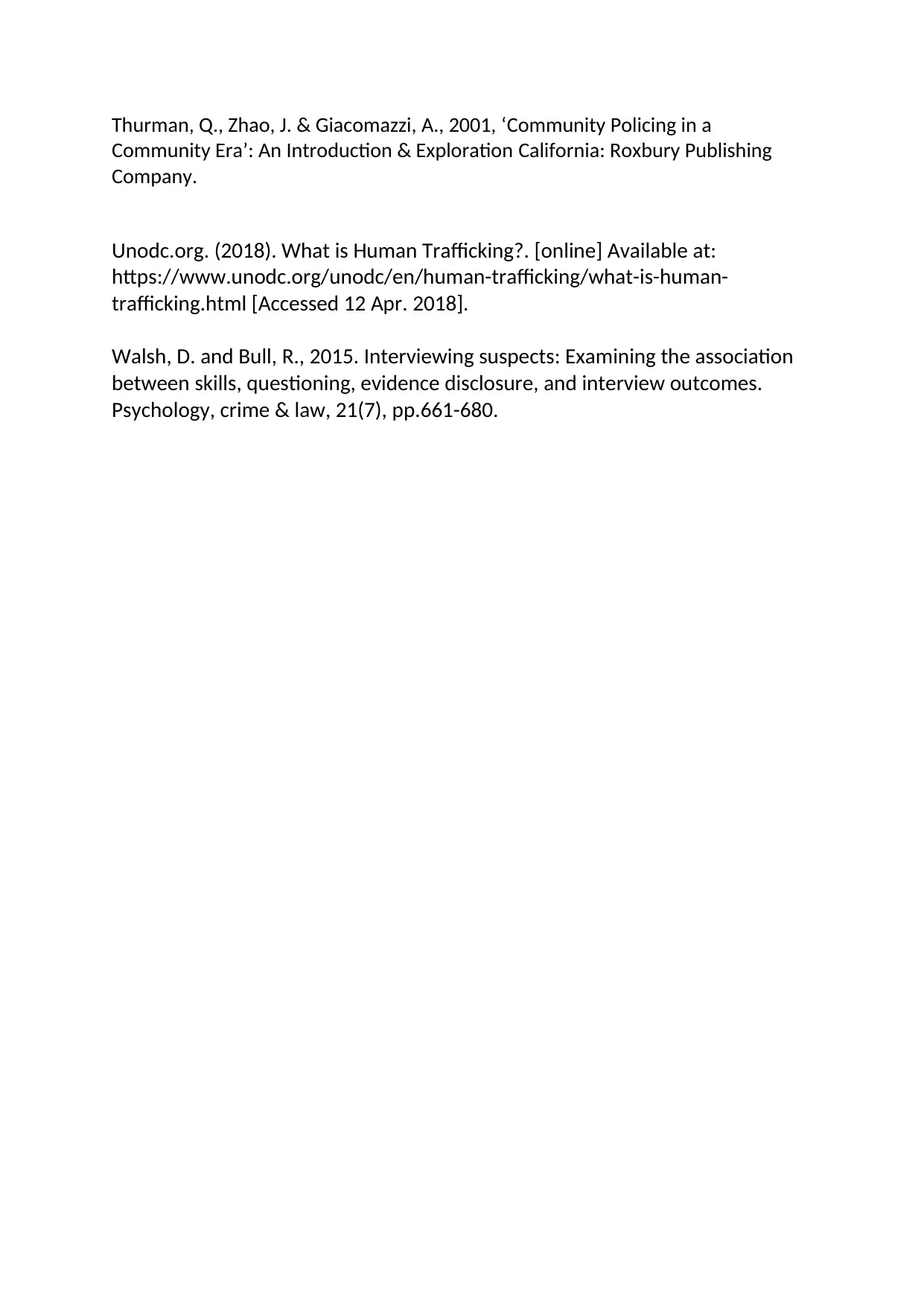
Thurman, Q., Zhao, J. & Giacomazzi, A., 2001, ‘Community Policing in a
Community Era’: An Introduction & Exploration California: Roxbury Publishing
Company.
Unodc.org. (2018). What is Human Trafficking?. [online] Available at:
https://www.unodc.org/unodc/en/human-trafficking/what-is-human-
trafficking.html [Accessed 12 Apr. 2018].
Walsh, D. and Bull, R., 2015. Interviewing suspects: Examining the association
between skills, questioning, evidence disclosure, and interview outcomes.
Psychology, crime & law, 21(7), pp.661-680.
Community Era’: An Introduction & Exploration California: Roxbury Publishing
Company.
Unodc.org. (2018). What is Human Trafficking?. [online] Available at:
https://www.unodc.org/unodc/en/human-trafficking/what-is-human-
trafficking.html [Accessed 12 Apr. 2018].
Walsh, D. and Bull, R., 2015. Interviewing suspects: Examining the association
between skills, questioning, evidence disclosure, and interview outcomes.
Psychology, crime & law, 21(7), pp.661-680.
1 out of 8
Related Documents
Your All-in-One AI-Powered Toolkit for Academic Success.
+13062052269
info@desklib.com
Available 24*7 on WhatsApp / Email
![[object Object]](/_next/static/media/star-bottom.7253800d.svg)
Unlock your academic potential
Copyright © 2020–2025 A2Z Services. All Rights Reserved. Developed and managed by ZUCOL.





